What does a cushion diamond cut look like?
A cushion diamond cut is a square or rectangular-shaped diamond with rounded corners and larger facets. It has a soft and romantic appearance, often described as a combination of a round brilliant and a princess cut. The cushion cut is known for its exceptional brilliance and timeless elegance.
I'll start off by saying that I am totally biased when it comes to cushion diamond cuts. They are my absolute favorite diamond shape, and I shall not apologize for my love. The shape has been around since the early 1800s and is now one of the most popular diamond shapes, so it’s safe to say these little gems are doing something ‘right’. Diamond Pun!
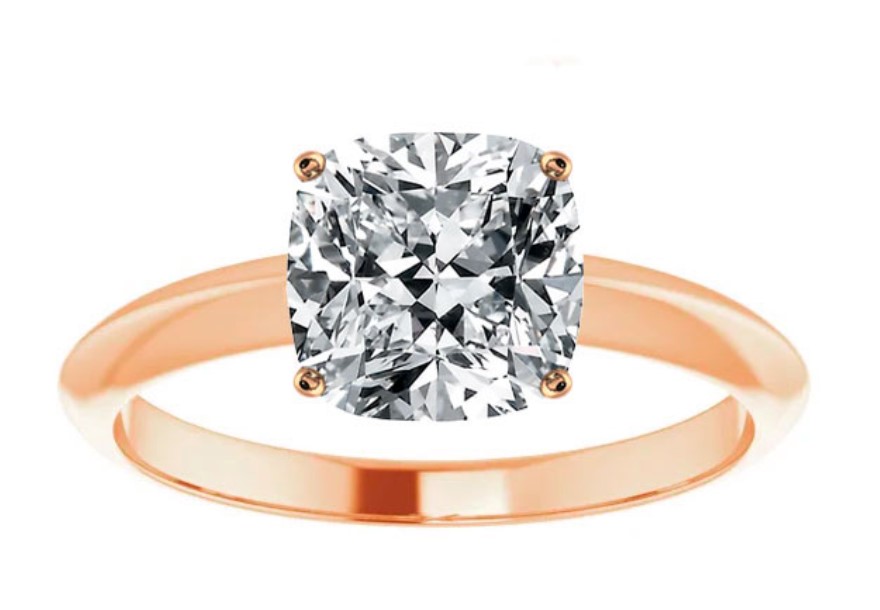
What I love the most about cushion diamonds is their versatility. Unlike many of the other fancy cuts we’ve covered, cushions are no one-trick ponies. There is actually more than one type of cushion diamond cut, so there’s lots of variety to be found depending on your individual taste.
Antique Cushion Cuts
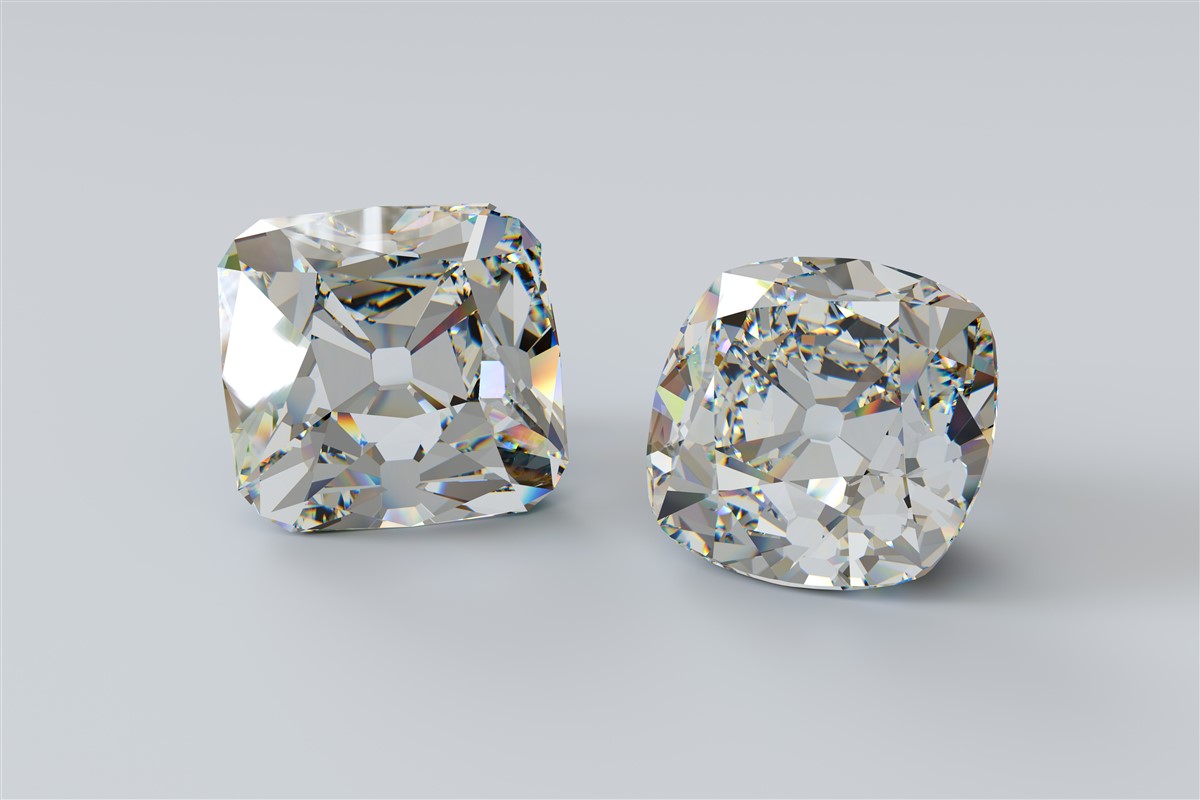
Let’s start with the antique cushion cuts (also known as old mine cuts or old mine brilliants). It is hard to find these antique cushion diamond cut with buckets of sparkle, although they do give off lovely flashes of light. They definitely have a less ‘refined’ look, however, I know some people who absolutely love that retro vibe. All I will say is that be sure to take a very close look at the polish and symmetry grade on the report before you take the plunge on one of these stones; frequently, they are only ‘good’ or even ‘fair’.
Modern Cushion Cuts
Then we have the modern cushion cuts, and just to make things even more complicated, there are two types of modern cushions cut; the regular/standard cushion brilliant cut, and the modified brilliant cut. More types of cushion diamond cut; confusing I know.
There is long-held confusion regarding how to tell the difference between these two types of modern cushion and what ‘look’ you get from each cut. Some argue that a regular cushion cut gives you a certain look, while the modified brilliant gives you another. This is simply not the case, and the looks are actually interchangeable within these cut styles!
But the difference is minuscule between them. In fact, it’s really only down to the size of the facets on the two different cuts that hold them apart. With this in mind, my advice to you is not to get bogged down with all of this confusing terminology and instead focus on what sort of ‘look’ you want your diamond to have. Take a look at these to see what I mean.
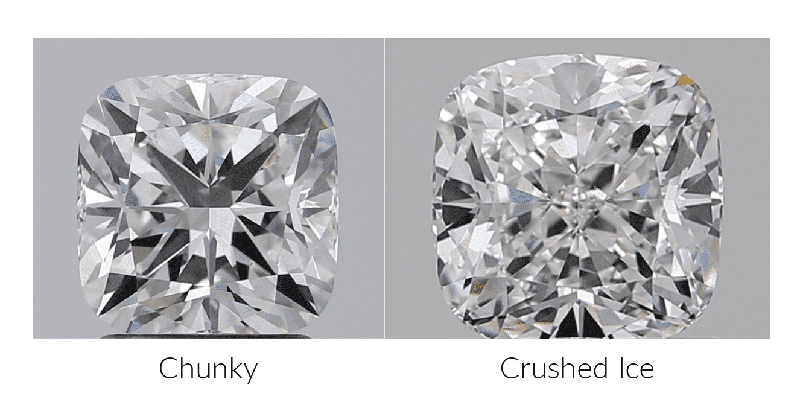
Crushed Ice Cushions
The diamond on the right has what is known as the ‘crushed ice’ look. This look resembles that of a radiant cut diamond, in that it has little identifiable patterning. Instead, it has a beautifully chaotic vibe, almost like shattered glass. These types of cushions give off the most amazing flashes of light, and are real show-stoppers.
Cushion Diamond Color and Clarity Guide
The only piece of advice with these is to try and go higher on color grade if you can, because they tend to hold the color more than other cushion cut diamonds. ‘H’ color or above will give you a nice white stone in your engagement ring. When it comes to clarity, go down to ‘SI1’ (or even an eye clean SI2’ if you can find one) given the forgiving nature of this look.
Chunky Look Cushions
The stone on the left has what is known as the ‘chunky’ look. You can see clearly that there is a definitive pattern going on inside that stone, and because of this, you get a much more organized and sharper look. This look is going to knock your socks off with brilliance and fire, so prepare to be impressed, my friend.
Color and Clarity
These types of cushions actually behave very similarly to round brilliant diamonds, in that they hide color and inclusions very well. For this reason, I say go as low as ‘I’ or even ‘J-K’ if you like a tiny bit of warmth, and as low as SI2 if you find an eye clean one.
You will need to see the stone in order to gauge if it’s going to be right for you.
Proportions for Cushion Diamonds Cut
Furthermore, it is very difficult to get a general standard for ideal dimensions and proportions. It is widely accepted within the industry that a cushion is best judged by the eye, rather than searching for a stone fitting a set criteria. That said, many gemologists would suggest sticking within the following ranges:
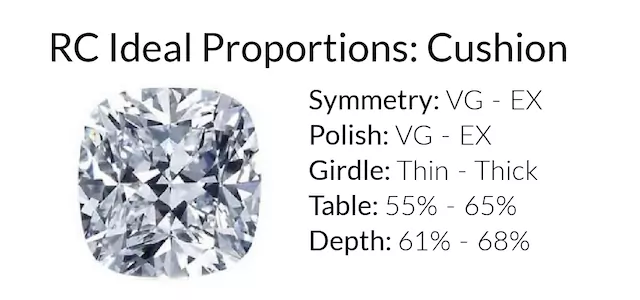
A Quick Note on Length to Width Ratio for Cushion Cuts
Traditionally, a cushion diamond cut is usually square or just a tad bit elongated. The closer the length to width ratio is to 1, the more square it will be. Lately though, elongated cushions have become all the rage. We suggest starting at 1.10 L/W to find an elongated stone. Just keep in mind, the further away from 1 you are, the longer the stone is going to be. Go too elongated and you could run into a bow tie (no bueno). Lucky for you though, we have a staff of Graduate Gemologists on standby to 1. help you search for a diamond and/or 2. look over the quality of any diamond you've already found! Just click on the little chat button over in the right-hand corner of this page to be connected.
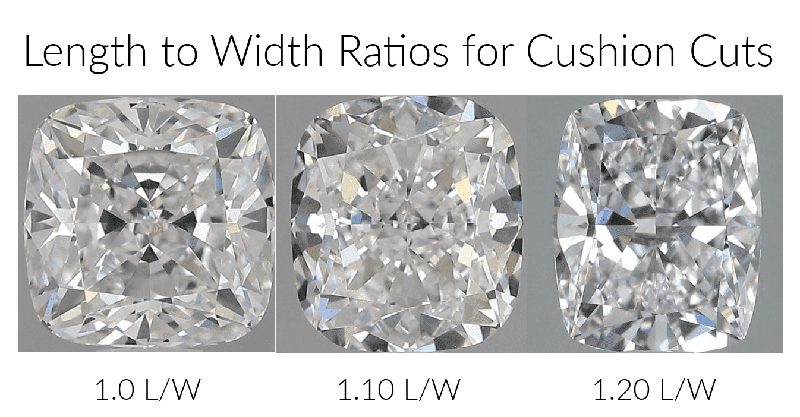
Read More About Cushion Cuts Here:
- Round vs. Cushion Cuts
- The Cushion Cut Buyers Guide
- All About Square Engagement Rings
- Whats the best cut grade for this shape? Read more here!
Read these articles for other Shapes and Cuts;
- Marquise diamond cut buying guide
- Heart diamond cut buying guide
- Cushion diamond cut buying guide
- Oval diamond cut buying guide
- Round diamond cut buying guide
- Radiant diamond cut buying guide
- Pear diamond cut buying guide
- Asscher diamond cut buying guide
- Princess diamond cut buying guide
Follow us on Social: Facebook * Instagram * Pinterest * Twitter

